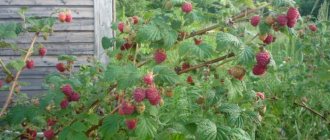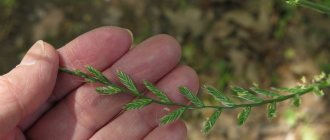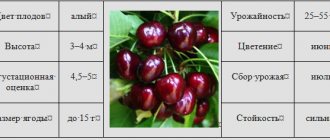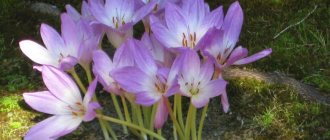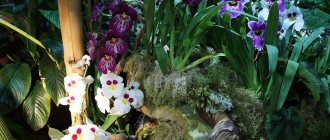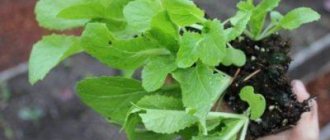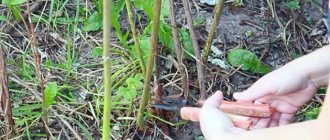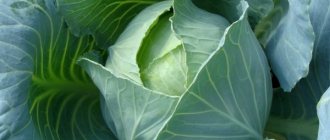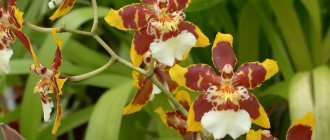Features of the Vanilla orchid
Vanilla is a vine plant up to 30 meters long, native to the Antilles, Panama and Mexico. There are more than 100 species of this plant in nature, most of them are epiphytes. Their favorite support is chocolate trees.
Of the entire variety, only 2 species form fruits and produce seeds, but it is almost impossible to obtain them at home. Despite the lack of fruits, all varieties of the plant are distinguished by their beautiful appearance and pleasant aroma.
External and species characteristics of the Vanilla orchid:
- The stem is powerful, curly, rich green in color. Aerial roots are formed along its entire length, with which the plant clings to the bark of trees.
- The leaves are fleshy, with pointed tips. The color of the leaves is dark green, with light stripes in variegated species.
- Peduncles are short, formed in abundance in the axils of the leaves. Each has 3–5 buds. The shade of the petals depends on the variety, mostly yellow-green. In the center there is a tubular lip with a white edging along the edge.
- Flowering occurs in spring and lasts 5–6 weeks. The plant forms its first buds at the age of 3–4 years.
Plant propagation methods
Are vanilla orchid seeds suitable for planting? It is important to note that the fruits in store-bought vanilla pods are completely non-viable. They were subjected to heat treatment, and therefore are suitable only for use in cooking. Viable seeds can be found commercially, but to obtain viable seedlings you need a florarium (plant terrarium).
A simpler and more acceptable way to propagate a vanilla orchid is by cuttings. To do this, you need to select that part of the shoot where there are at least three nodules with aerial roots.
The cuttings must be treated with a growth stimulant (for example, heteroauxin). Next, the shoot must be placed in a container with moistened soil (preferably with sand), covered with polyethylene, creating greenhouse conditions. Periodically you need to ventilate the sprouts by opening the greenhouse. When the seedling begins to grow noticeably, the film should be completely removed. After the first 3 leaves appear, the plant needs to be transplanted into a prepared substrate. The container must be plastic and transparent, always with drainage holes. As noted above, the vanilla orchid is a vine that requires support. It is necessary to provide it for the small sprout as well.
Variegated species of vanilla orchid
Of the 100 existing species of vanilla orchid, only three are used to produce spice:
- Flat-leaved (Vanilla planifolia). The most popular species, perfectly adapted to growing at home. The flowers are yellow or green-yellow, blooming alternately. Therefore, the total flowering time is 3–4 weeks.
- Lemon Splash. A varietal variety that forms long aerial roots of a grayish tint. The leaves are large, fleshy, elliptical in shape, dark green. The flowers are lemon yellow.
- Tahitian (Vanilla tahitensis). A hybrid of flat-leaved and fragrant vanilla. The flowers are red-brown. Pods up to 14 cm long. The aroma contains tobacco notes.
Botanical description
Vanilla planifolia belongs to the Orchid (Orchideaceae) and is a herbaceous, flowering, liana-like epiphytic plant.
The stem of Vanilla flatifolia reaches 20 m in length, climbing, branched, cylindrical in shape. An aerial stem emerges from almost every node and grows up to 50 cm.
Fleshy, alternately sessile, oblong-lanceolate leaves taper into a short groove, smoothly turning into a petiole. Flowering occurs from spring to early summer. Yellow-green flowers are collected in a racemose inflorescence, reaching up to 6 cm in length.
After flowering, a fruit is formed - a pod, which is the source of aromatic vanillin. Due to its epiphytic properties, it feels best in spacious rooms, with the ability to curl and grow.
How to grow a flower at home?
Growing this type of orchid at home is not very difficult, the main thing is to create conditions for it that are close to natural:
- temperature +25...+30 degrees throughout the year; the minimum acceptable values are +18…+20 degrees;
- air humidity level - 80–90%;
- diffused but quite bright light.
Important! It is quite difficult to create optimal illumination for a plant. On a southern window there is a better chance of achieving abundant flowering, but the leaves may get burned. When placed on an eastern or northern windowsill, the foliage will look perfect, but the buds will not form.
Preparing for landing
In its natural environment, Vanilla grows on the trunks of tall trees. At home, it is planted in hanging pots that provide conditions for creeping stems. When planting in a regular pot, a support is installed above the plant to secure the aerial roots to the stem. Experienced flower growers advise using a mesh stretched between vertically installed slats.
The soil for planting is prepared loose and as ventilated as possible. The composition of the substrate differs from the traditional one, which is used for growing other types of orchids. The mixture is prepared from the following components:
- garden soil - 2 parts;
- fern bark, pine trees and sphagnum moss in equal quantities - 1 part;
- perlite - a small amount;
- charcoal - to the bottom of the pot.
For your information! Special baskets are best suited for growing this species. In this case, the vine wraps around. An acceptable option is a clay or plastic pot with additional support. There should be at least 3 cm of free space between the pot and the root system.
How to plant an orchid?
The planting technology is as follows:
- The container is disinfected, drainage is placed on the bottom, and a small amount of substrate is placed on top.
- Install the prepared cutting, deepening it by 2 eyes.
- The remaining space is freely filled with soil without compacting it.
- Cover the cutting with a transparent cap to create greenhouse conditions.
Rules of care
Basic measures for caring for an orchid:
- Watering by immersion in settled water, heated to +30...+45 degrees. The pot is lowered into the container for 10–15 minutes, then the liquid is allowed to drain. The frequency of soil moistening is regulated individually. The soil should not dry out, but waterlogging should also not be allowed.
- Feed 1-2 times a month. It is better to use special fertilizers for orchids. If there are no special compounds, you can use any fertilizer for flowering indoor plants. The concentration of the solution in this case is reduced by 4 times.
- Trimming. For the Vanilla orchid, this procedure is mandatory, otherwise the vine will grow up to 15 meters in length. After pruning, the plant begins to produce side shoots.
Transplantation and propagation
Young plants are replanted every year, adults - once every 2-3 years. The best time to carry out the procedure is spring, before the growing season begins. The plant is carefully removed from the old pot so as not to damage the roots and transferred to a new container. The resulting voids are filled with a nutrient substrate.
The fruit of the Vanilla Orchid contains seeds, but growing a new specimen from them is quite problematic. Therefore, for propagation, it is preferable to use apical cuttings, especially since they remain after pruning the plant.
Rooting consists of the following stages:
- The shoot is divided into parts 30 cm long, and the lower cut is treated with a root formation stimulator.
- Place the workpiece in a damp substrate and cover with a transparent cap.
- Place the cutting in a warm place. Regularly moisten the soil and remove the cap for a short time for ventilation.
Important! The first watering after transplanting an orchid is carried out 2 weeks after the procedure. Feeding - no earlier than after 30 days.
Common diseases and their treatment
Violation of the agricultural technology of growing orchids provokes the development of diseases:
- Stem rot. It affects plant shoots due to excessive watering. Changing the soil and then reducing the frequency of watering helps normalize the condition of the orchid.
- Root rot. Causes blackening of roots due to stagnation of moisture in the pot. The diseased plant is removed from the soil, the rotten parts are cut off, the healthy roots are treated with a fungicide and the orchid is planted in new soil.
- Late blight. A fungal disease caused by a combination of cold air and high humidity. Brownish spots appear on leaves that dry out and fall off. They destroy fungal spores with copper-containing preparations (Hom, Oksikhom).
- Blackening of aerial roots. The reason for this phenomenon is excess fertilizer. It is recommended to take a break in fertilizing for 30 days, then reduce the concentration class=”aligncenter” width=”700″ height=”394″[/img]
- Yellowing and drying of leaves. Indicates a lack of moisture in the soil and air. It is necessary to adjust watering and take measures to increase the humidity level in the room.
Transfer
Transplantation of the Vanilla Orchid is carried out due to wear and tear of the soil or if its roots do not fit in the pot. This happens once every two to three years. It is best to replant in the spring .
To do this, you need to very carefully remove the plant from the old pot without damaging the root system. To avoid the formation of rot on those roots that do break, they must be sprinkled with ground charcoal. The new container should be slightly larger than the previous one, just a few sizes.
It is recommended to slightly limit the transplanted flower's watering and gradually increase the dose of sunlight.
Video on how to properly replant a Vanilla Orchid
Florist recommendations
Caring for various types of Vanilla orchids has some nuances that experienced gardeners willingly share:
- Vanilla flatifolia prefers heavy spraying to watering. It should be watered moderately, moistening the leaves several times a day.
- With hand pollination you can get pods of an expensive spice. The green fruit ripens after 7 months. Then it is processed in a certain way and used to flavor dishes.
- For irrigation, you can only use water that is completely free of lime. Otherwise, the roots will be damaged and the plant will begin to hurt. It is advisable to freeze the water and then defrost it. Before watering, the water is heated to +30…+35 degrees.
Advice! In order for the orchid to bloom, it is placed on the south window, but from 11:00 to 15:00 it is covered with a translucent protective screen.
Vanilla Orchid is an original plant with a pleasant aroma. But flowering of this variety can only be achieved under ideal conditions and with proper care technology.
Lighting and temperature
lighting for Vanilla flatifolia . Diffused light is precisely the source that allows the plant to actively grow. The orchid should be placed in the southeastern or southwestern parts of the house or garden. It is important to leave a lot of space for her with the idea that Vanilla is curling and she needs more space in the future.
Article on the topic: Hawthorn pentapalm - beneficial properties, description
Flat-leaved vanilla is heat-loving and the optimal indicator for it can be +22+25°C. It is important that this temperature remains in the same range without sudden changes.
Soil and fertilizer
For good growth and development, Vanilla flatifolia needs a special substrate that is suitable for orchids. The plant is replanted every three to four years or as needed in a wide or medium-high container. In equal parts to prepare the substrate take:
- roots of common fern;
- deciduous soil;
- crushed roots of osmunda fern.
at the bottom of the plant pot. For these purposes, you can use expanded clay of the middle fraction or other materials suitable for this.
